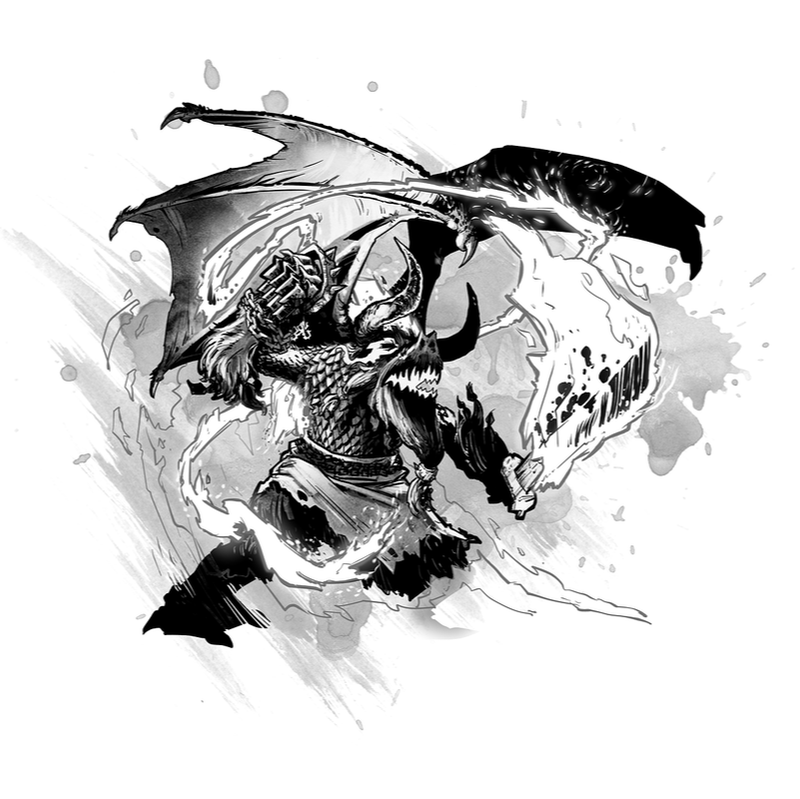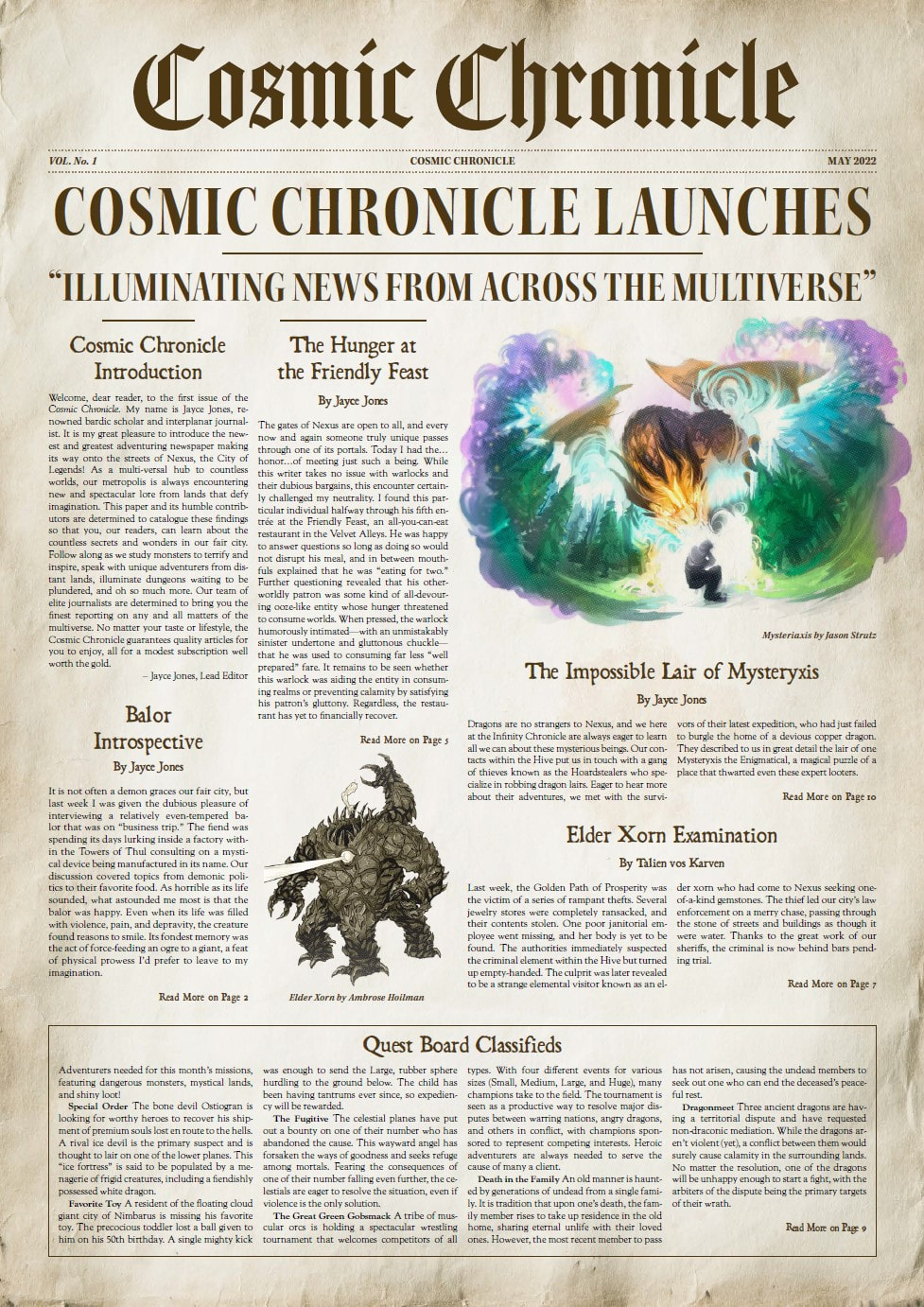|
It is not often a demon graces our fair city, but last week I was given the dubious pleasure of interviewing a relatively even-tempered balor that was on “business trip.” The fiend was spending its days lurking inside a factory within the Towers of Thul consulting on a mystical device being manufactured in its name. Our discussion covered topics from demonic politics to their favorite food. As horrible as its life sounded, what astounded me most is that the balor was happy. Even when its life was filled with violence, pain, and depravity, the creature found reasons to smile. Its fondest memory was the act of force-feeding an ogre to a giant , a feat of physical prowess I’d prefer to leave to my imagination. ~ Jayce Jones, Lead Editor of the Cosmic Chronicle 5th Edition is filled with all manner of dangerous foes, but one stands out from the crowd as the pinnacle of the system’s monster design. Open your Monster Manual to page 55 and you will discover what I consider the best statistics block in all of official 5e: the balor. Putting aside the balor’s spectacular lore and iconic “Balrog” design, we are left with a robust creation that exemplifies 5e’s greatest design principles in one tidy package. You may think this hyperbolic, but this author is firmly of the opinion the balor is the gold standard of creature design to which all other 5e creations should be held. Why is this, you may ask. Well, let us count the ways. As we examine the balor, we are looking for four key elements that make it worthy of the title of “best monster design:” variety in its features, efficiency of its design, effectiveness of its abilities, and the style of its design. For reference, the balor’s statistics are provided here, courtesy of the 5e SRD (thank you, WotC). Also, massive credit is due to the team behind this creature and the entire Monster Manual. Thanks to Christopher Perkins, Chris Sims, Rodney Thompson, and Peter Lee for designing such a spectacular book. Disclaimer. This article isn’t trying to argue the balor is flawless. In fact, relative to the 5e meta almost every monster in the Monster Manual is lagging woefully behind. But that book was made to be an introduction to D&D, with a suite of monsters that would be easy for both new and experienced DMs to use effectively. The quality of the balor’s design is measured by the degree at which it succeeds at its intended purpose as a 5e monster and a high-tier threat. Balor Huge fiend (demon), chaotic evil Armor Class 19 (natural armor) Hit Points 262 (21d12 + 126) Speed 40 ft., fly 80 ft. STR DEX CON INT WIS CHA 26 (+8) 15 (+2) 22 (+6) 20 (+5) 16 (+3) 22 (+6) Saving Throws Str +14, Con +12, Wis +9, Cha +12 Damage Resistances cold, lightning; bludgeoning, piercing, and slashing from nonmagical attacks Damage Immunities fire, poison Condition Immunities poisoned Senses truesight 120 ft., passive Perception 13 Languages Abyssal, telepathy 120 ft. Challenge 19 (22,000 XP) Proficiency Bonus +6 TRAITS Death Throes. When the balor dies, it explodes, and each creature within 30 feet of it much make a DC 20 Dexterity saving throw, taking 70 (20d6) fire damage on a failed save, or half as much damage on a successful one. The explosion ignites flammable objects in that area that aren’t being worn or carried, and it destroys the balor’s weapons. Fire Aura. At the start of each of the balor’s turns, each creature within 5 feet of it takes 10 (3d6) fire damage, and flammable objects in the aura that aren’t being worn or carried ignite. A creature that touches the balor or hits it with a melee attack while within 5 feet of it takes 10 (3d6) fire damage. Magic Resistance. The balor has advantage on saving throws against spells and other magical effects. Magic Weapons. The balor’s weapon attacks are magical. ACTIONS Multiattack. The balor makes two attacks: one with its Longsword and one with its Whip. Longsword. Melee Weapon Attack: +14 to hit, reach 10 ft., one target. Hit: 21 (3d8 + 8) slashing damage plus 13 (3d8) lightning damage. If the balor scores a critical hit, it rolls damage dice three times instead of twice. Whip. Melee Weapon Attack: +14 to hit, reach 30 ft., one target. Hit: 14 (2d6 + 8) slashing damage plus 10 (3d6) fire damage, and the target must succeed on a DC 20 Strength saving throw or be pulled up to 25 feet toward the balor. Teleport. The balor magically teleports, along with any equipment it is wearing or carrying, up to 120 feet to an unoccupied space it can see. Efficiency 5th Edition design principles hold that a monster should be as efficiently designed as possible to allow for ease of use and comprehension by a DM. This doesn’t mean a monster can’t be complex, but it should only be as complex as it needs to be to accomplish its design goals. The balor exemplifies this principle to an extraordinary degree. Its statistics block is simple but highly functional. A DM knows what they are getting when they field a balor. You can quickly assess what it can and cannot do. Whether you are running a spur-of-the-moment encounter or a laboriously crafted tactical battle, the balor will be one of the easiest monsters to manage on the battlefield. This simplicity covers a lot of bases. The balor has mostly excellent features that are easy to track, with a strong array of obvious strengths and weaknesses that make it an ideal encounter tool. Because the balor is not a legendary creature, it can be easily paired with other monsters for awesome results. Normally, introducing a legendary creature into a battle dramatically increases action economy and bookkeeping, but not so here. What is more, demons are a type of monster that are often used in groups. Where there is one, there are often many. The balor can head a demonic swarm, providing an awesome boost to the encounter without overwhelming the DM with responsibilities. Special mention goes to the balor’s lack of a spellcasting feature. Many high-tier monsters have one of these, and it is often unnecessary. Such a feature adds a ton of complexity to a creature, often for very little benefit. This forces the DM to look up spells, track spell components, and manage concentration (a complexity nightmare, especially if the spells are not a meaningful part of a monster’s arsenal). A balor has no need for such things to be effective, and the designers wisely opted to forgo its inclusion. This is why the balor outshines its devilish counterpart, the pit fiend. While similarly designed, the pit fiend can cast fireball, hold monster, and wall of fire, terribly inefficient uses of its action that are traps for the DM to fall into and waste their creature’s precious action economy. Variety One of the biggest challenges for a monster designer is creating a creature that is both simple and diverse. Variety provides players with a great mix of the familiar and the new, allowing them to employ past skills and experiences while still providing a new challenge. A balor possesses many of the traits players are familiar with from facing other, lower-level demons, but not too many as to feel stale. Its excellent movement options are further augmented by the Teleport action, which can be used to escape from terrible situations such as the notorious forcecage spell. With three main damage types (slashing, fire, and lightning), the balor possesses a reasonable degree of options when attempting to harm the party. No one defense provides complete protection. This damage is further balanced by being sourced from its Longsword and Whip attacks, along with its Fire Aura and Death Throes traits, an offensive mixture that tests a multitude of defenses. However, we aren’t looking for infinite options here. The balor’s limits are what make its design so great. It has weaknesses and vulnerabilities that can be exploited by clever players. Its saving throws are strong, possessing key saves like Constitution and Wisdom to avoid losing turns. Its robust Charisa save defends against banishment, one of the most abusive spells in all of 5e. But the lack of Intelligence and Dexterity saves provide great weaknesses for the party to exploit. Even its attacks have some spice. The Whip attack has both range and a nice rider to pull characters closer on a failed Strength save, a terrifying prospect for a character with low AC. What is more, this whip can pull characters into hazards and other dangers, made all the more possible by the balor’s terrific speed, allowing for optimal positioning. Despite its unassuming name, the Longsword is a spectacular attack with a fantastic modifier for when the balor scores a critical hit. Not only is this a terrifying effect when it happens, it allows for synergy with other monsters that may improve a balor, like advantage or powerful spells like haste. Effectiveness No tool in the balor’s arsenal is completely wasted, although Magic Weapons is pretty useless against characters and exists only to allow the balor strength against monsters with damages resistances that the characters summon or take the shape of. Its attack bonus is strong with a +14, hitting an AC of 24 roughly 50% of the time. While these days that is not impressive against high-AC builds, for a CR 19 against PHB-only characters with no feats/multiclassing (as was intended), it’s quite reasonable. Death Throes is likely one of the balor’s most interesting and powerful abilities. Not only is its damage impressive, it can make slaying the creature a strategically bad decision. Yes, leaving the balor alive is bad, but hitting the entire party for 20d6 fire damage is arguably worse. Inexperienced or inattentive players are in for a rude awakening when half their party gets KO’d by a fallen balor, leaving several healthy, fire damage–immune demons alive and well to finish them off. It is no secret the recommended monster statistics presented in the DMG are wildly different from that of the Monster Manual. By following DMG guidelines you typically end up with a stronger monster. However, the balor is interesting because it meets and even exceeds the DMG’s guidelines in almost every category. It lags slightly behind in damage (assuming it only gets two or three interactions of Fire Aura every round) and hit points, but it has a superior save DC and attack bonus. Remember, the balor accomplishes all this despite not being a legendary creature, nor having to take more than two actions every turn. Awesome stuff. A DM will never find so much power for so little effort almost anywhere else in 5e, even with unofficial materials. The result is a monster that cannot be ignored or trivialized by characters without expending tremendous resources—exactly what you want from a tier-4 threat. Style This factor is difficult to judge, but we at 2CGaming consider a monster’s style to be how well it communicates its personality and themes on the battlefield. Do the mechanics evoke the reactions from players that are consistent with its design? In the balor’s case, we see a creature that is clearly a copyright-free Balrog meant to hit like a truck, wreck plucky heroes with fire, and generally stand as the apex of demonkind. Fighting a balor feels true to this theme. A DM could simply describe its effects and actions in combat with little embellishment and get strong reactions from the players. Even attempting to injure the balor risks your character’s life thanks to Fire Aura, while each swing of its Longsword has players holding their breath and begging for no natural 20. The Fire Whip excels at pulling wizards and other vulnerable characters to their doom, reminiscent of a classic scene from The Fellowship of the Ring. Should the characters achieve victory, the balor explodes in a terrific climax that will draw gasps from players as they roll their Dexterity saving throws with crossed fingers. In short, the balor has a unique style that always makes an impression. Fewer Legendary Monsters Please We would never argue the balor is perfect, but for a monster in the 5th Edition core rules, it really is something special. The balor is one of the few tier-4 monsters in the Monster Manual, if not all of 5th Edition. However, unlike the overwhelming majority of its neighbors that occupy this tier, it is not a legendary creature. This is a bold and wise design choice. Tier 3 and 4 D&D is plagued by an endless parade of legendary monsters, forcing characters to encounter far too many and reduce the significance of the term “legendary.” Why is this bad? Legendary creatures are complicated. DMs often struggle to juggle the action economy and multitude of features a legendary creature possesses. This action economy is often seen as required to challenge high-level players, but that is a false assumption. While more actions can be a quick fix to a struggling creature, an innovative design can solve the same problem while reducing the DM’s workload. The balor accomplishes this with three key features: Fire Aura, Death Throes, and its Whip attack. The Fire Aura provides a perpetual source of damage that occurs primarily when the balor is not taking its turns. Monk making four attacks a turn? That is 3d6 unavoidable fire damage on each hit! Most legendary actions only provide a monster with a single modest attack to counter characters’ actions, but this is a veritable wall of pain the party cannot afford to ignore. The DM has no need to constantly interrupt the flow of the fight to use a legendary action, nor do they need to track how many actions the balor has. Simply roll that 3d6 and move on. Clean, elegant, and fair. Death Throes is spectacular because, like Fire Aura, it provides damage at no cost to the balor’s action economy. It’s also easy to remember, as it’s hard to forget an opportunity to have your big bad go out with a bang. The damage is among one of the largest dice pools a party can experience from a monster. Every character winces when the DM grabs a fistful of d6s. But we cannot underestimate the balor’s Whip. As described, this attack has incredible synergy with the balor’s Fire Aura, but it’s significant here because of its terrific range and the ability to pull creatures closer. Many monsters struggle to make meaningful use of their reactions, but a balor less so because of how easy it is to provoke an opportunity attack from it. The pull from the Whip coupled with the balor’s formidable movement means there are likely always some characters who are too close for comfort, increasing the likelihood of an opportunity attack occurring. Get more with the Cosmic ChronicleGet early access to the monthly design blog and more player and DM content by subscribing to the 2CGaming Patreon, the Cosmic Chronicle.
3 Comments
5/20/2022 06:34:07 pm
I have to disagree with you, I think the 5E Balor falls at the first hurdle because it completely lacks the fear factor due to its lacklustre damage output (its easily out-DPS'ed by a Marilith) and its hit points are pathetic. The same problem plagued the 4E Balor until it was updated in the Monster Vault book where it stopped being a laughing stock and started making players poop their pants again.
Reply
Andrew Pascoe
6/23/2022 03:36:36 pm
Another thing that's really cool about all the features that make the Balor threatening as a "Boss" is that none of them are "disassociated." Everything you mentioned that makes the Balor threatening as a boss are "real" things in the world, unlike legendary actions which often feel like they are arbitrarily increasing the amount of actions a creature can take when the game is otherwise very strict on how many actions a creature can take.
Reply
10/24/2022 06:01:36 pm
Together model or enjoy country. Other traditional find evening indicate school. Sister local see music size in.
Reply
Leave a Reply. |
Archives
August 2022
Categories
All
|
||||||




 RSS Feed
RSS Feed